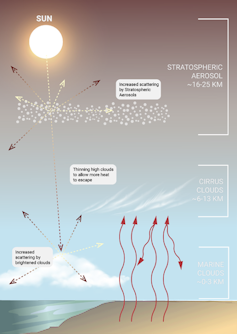Solar Radiation Modification (SRM) is a suite of possible technologies to counteract global warming by reflecting incoming solar radiation.
Some SRM proposals involve the injection of reflective aerosols into the stratosphere; others include cirrus cloud thinning and marine cloud brightening.
In all cases, SRM proposals are intentional human interventions in the climate system that aim to reduce global warming by increasing the reflectivity of the Earth rather than by decreasing human greenhouse gas emissions.

Climate model experiments, as well as reports from the IPCC, the United Nations Environment Programme and the European Commission show that these technologies could potentially slow the rate of global warming and even cool the planet. However, these same reports also caution that SRM technologies could themselves change the climate in ways that would generate severe adverse impacts.
There is no global consensus around SRM as a climate change response strategy.
At the recent Sixth United Nations Environment Assembly (UNEA), attended by one of the authors, Jennifer Garard, world governments were unable to come to an agreement on whether to call for a scientific assessment of the potential and risks of SRM deployment and the resolution was withdrawn.
As climate scientists, we argue that a robust and democratic scientific assessment process, enriched by the inclusion of the perspectives of diverse stakeholders, would be an important step forward to help the global decision-making community build consensus around this critical and controversial topic.
The risks
Deploying SRM technologies, or even testing these technologies in real-world settings, would carry risks. Many of these risks remain poorly understood.
SRM actions could have severe negative impacts on ecosystems and biodiversity, air quality and the ozone layer and agricultural productivity. These impacts are likely to be felt unequally across the Earth and could further exacerbate existing challenges related to environmental justice and equity.
Moreover, deploying SRM technologies in the absence of rapid emissions cuts would produce a dangerous dependence on sustained SRM action to maintain its climate effect. In this scenario, if SRM were stopped suddenly, the so-called termination effect would cause rapid warming with the potential for substantial harm to multiple life-sustaining systems around the world.
These questions raise additional concerns of intergenerational injustice, in which future generations may have no choice but to continue with SRM deployment to avoid the consequences of terminating it.
Surface level
By definition, SRM does not address the accumulation of greenhouse gases which are the root cause of climate change. Consequently, there is an additional risk of distracting attention and resources away from the need for rapid and profound emissions cuts.
On top of its potential for distraction, SRM technologies cannot address the problem of ocean acidification and may also pose challenges to using solar energy to support decarbonization.
The costs of SRM deployment are also high with one estimate placing this value at US$2.25 billion per year over the first 15 years of deployment — funds which likely would be much better spent on emissions reductions efforts.
Simply put, despite several decades of research and discussion, there remains no comprehensive scientific assessment of SRM risks and uncertainties. Such an assessment is critically needed to underpin multilateral discussions and inform governance frameworks.
SRM technology is likewise a highly controversial topic in global environmental negotiations. A resolution was put forward by Switzerland at the most recent UN Environment Assembly to mandate the UN Environment Programme to convene a scientific expert group to assess SRM.
Opposition was strong from various quarters. Leaders from many African nations joined forces to advocate for a strict non-use agreement rather than a scientific assessment. Meanwhile, the Joint Global Statement from Major Groups and Stakeholders stated bluntly that:
“SRM is basically fighting multidecadal, global-scale pollution with multidecadal, global-scale pollution.”
Other countries were opposed to the resolution but wished to keep the question of exploring the use of SRM open. Ultimately, no decision was reached.
What role for scientific assessments?
Given the significant risks involved, the issue of SRM governance urgently requires international attention and oversight. However, world governments at UNEA were unable to reach consensus on even assessing SRM, let alone on whether a non-use agreement could be implemented.
Most world government representatives at UNEA agreed on the need to avoid the serious risks of unilateral deployment of SRM technologies. However, we feel that the opposition to a scientific assessment of SRM may inadvertently enable individual countries or organizations to proceed with risky experiments.
Given the divergent global views on this topic, a non-use agreement appears unlikely in the short term. However, a transparent and inclusive assessment process could actually be an important step towards such an eventual agreement.
The International Panel on Climate Change is an important player in any assessment process given its strong history of rigorous scientific work on climate change. Likewise, the UN Environment Programme could also play a pivotal role and help bring in diverse stakeholders.
Mandating a trusted intergovernmental organization such as the United Nations to lead a rigorous and transparent assessment process that is inclusive of multiple perspectives would be a critical step towards SRM governance, including a potential non-use agreement.
Governance of SRM is of the utmost importance, precisely because of the high level of controversy surrounding this suite of technologies. A non-use agreement is one potential governance strategy, though international discussions currently seem a long way from being able to agree on such an outcome. The only way to break this deadlock is to carry out a transparent and inclusive scientific assessment process.
Jennifer Garard receives funding from the Social Sciences and Humanities Research Council of Canada. Her participation in the Sixth United Nations Environment Assembly was funded by the UN Environment Programme, where she holds the elected position of Major Groups and Stakeholders Regional Facilitator for North America.
H. Damon Matthews receives funding from the Natural Sciences and Engineering Research Council of Canada, Environment and Climate Change Canada and Microsoft Corporation.
This article was originally published on The Conversation. Read the original article.







